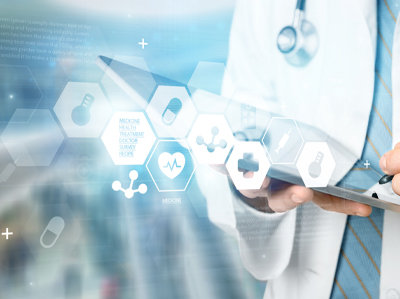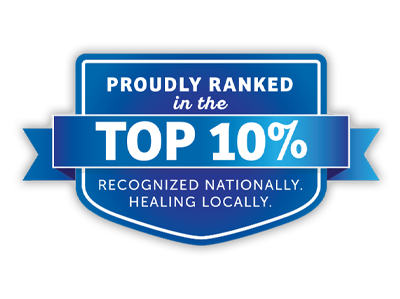Our Technology
We provide specialized rehabilitative services to our patients in the communities we serve. We often see patients who are recovering from disabilities caused by injuries, illnesses, or chronic medical conditions.
Our Technology
ZeroG® Gait and Balance System
The ZeroG Gait and Balance Training System helps individuals safely improve balance, gait and functional independence without the risk of falling.
ZeroG is a robotic, body-weight support system mounted to a motorized trolley that rides along an overhead track. To begin therapy, a therapist secures a patient into a comfortable harness that is attached to the ZeroG robot. The amount of support is individualized for each patient depending upon the patient’s level of ability.
The ZeroG software includes interactive balance training and games with visual feedback. Therapy information from each treatment session is recorded to allow the therapist to closely monitor recovery.
Who Can Use ZeroG?
Patients with the following conditions may be able to use the ZeroG treatment:
- Strokes
- Balance disorders
- Orthopedic injuries
- Traumatic brain injuries
- Incomplete spinal cord injuries
- Amputations
- Cerebral palsy
- Multiple sclerosis
- Parkinson’s disease
- Neurological injuries
- Cardiac patients in early recovery
Therapeutic Uses
Because ZeroG prevents falls, it can provide patients with greater confidence during therapy. Some of the therapeutic activities that ZeroG can be used for include:
- Walking
- Interactive balance exercises
- Learning how to anticipate a loss of balance
- Getting up from a chair
- Walking up and down stairs
- Stepping over floor obstacles
- Reaching activities
- Getting up from the floor
- Using assistive devices (canes, walkers, crutches)
Bioness
Our current Bioness® technology helps patients regain lost mobility or movement in their hands and feet. This system is especially useful for stroke patients, those who may have suffered a traumatic brain injury, Multiple Sclerosis, cerebral palsy, and patients with partial spinal cord injuries. The system uses electrical stimulation to help patients regain more muscle control, which in turn, gives them more function and mobility.
The Hand Rehabilitation System is easy to use and has been shown to facilitate the use of hand function not only during the acute phase of recovery for stroke patients and those suffering from a brain injury, but also in select patients whose injuries are years old.
The Foot Rehabilitation System is wireless, low-profile, and lightweight. It consists of three components: a gait sensor that’s worn in the shoe, a wireless stimulating leg cuff worn below the knee, and a clinician-programmed control unit. This technology allows the patient to achieve a more-normalized gait on changing terrains and at varying speeds.
Mountain Valley Regional Rehabilitation Hospital was the first to offer this technology in Northern Arizona.
LiteGait
LiteGait® is a gait training device that our staff uses to help patients comfortably walk in an environment free from falls. The system simultaneously provides proper posture, reduces weight bearing, eliminates concerns for balance, and helps in the training of lower body movement.
Its unique harness design creates and ideal environment for treating our patients who may have a wide range of impairments and ability levels. By allowing an increase or decrease in the weight-bearing load on the weaker side of the body, we may be able to begin gait training earlier in the rehabilitation process and at a lower weight-bearing level.
Vision Coach
A device to improve our patients visual and motor abilities that have been compromised by injury or disease processes. The tool can be used by physical therapy to incorporate balance and reaching tasks, as well as reaction times; by occupational therapy to improve visual scanning, visuo-perceptual skills and attentional skills; and by speech-language pathology to improve higher level attention skills and cognitive processing/executive functions.
The Vision Coach targets the following areas: central, peripheral and spatial awareness; divided attention; visual field deficits; fixation and location issues; speed of recognition and reaction times; visual attention/scanning/tracking; binocularity; eye-hand coordination; balance and coordination of movement; gross and fine motor skills; sensory integration; UB ROM; endurance and stamina; and cognition.
Surface EMG Biofeedback
This tool is used for swallowing therapy. In use with a computer screen, this tool allows patients/clients to visual the effort of his/her swallow, the accuracy of use of compensatory strategies, and endurance issues.
SaeboFlex
SaeboFlex is designed for patients suffering from neurological impairments such as stroke, who have limited hand abilities. It is a dynamic, custom-fabricated orthosis that supports the weakened wrist, hand, and fingers of a patient’s hand during therapy or at home. It is non-electrical and purely mechanical.
The brace attaches to the patient’s forearm, and fingers, positioning the wrist and fingers so functional activities can be performed. Using SaeboFlex, a patient can grasp an object by voluntarily flexing his or her fingers. An extension spring system assists in reopening the hand to release the object. The treatment principals of SaeboFlex are based on the latest advances in neuro-rehabilitation research that document the brain’s ability to “re-program” itself through mass practice, task-oriented arm training.
VitalStim® Therapy
The VitalStim® Therapy System is an FDA-approved, non-invasive, external electrical stimulation therapy provided to our patients who have dysphagia or trouble swallowing. The therapy is used in conjunction with swallowing exercises. By combining VitalStim and traditional therapy, we can accelerate strengthening, restore function, and help the brain remap the swallow.
Research supports the combination of these therapies to improve treatment outcomes. It has been shown to be safe and effective for patients, speed the recovery time from a restricted diet, and help patients achieve sustained improvements and long-term results.
Top 10%
Recognized in the Nation’s Top 10%
Mountain Valley Regional Rehabilitation Hospital has been ranked by the Uniform Data System for Medical Rehabilitation (UDSMR), a non-for-profit corporation that was developed with support from the National Institute on Disability and Rehabilitation research, a component of the U.S. Department of Education. It ranks rehabilitation facilities based upon care that is patient-centered, effective, efficient, and timely.
Through UDSMR, our hospitals collaborate with our peers throughout the United States to share information and establish best practices for patients. This helps us elevate rehabilitative care for everyone across the United States.




